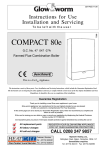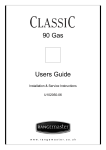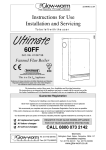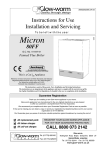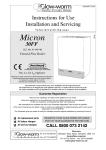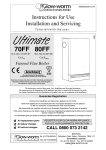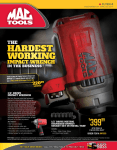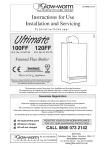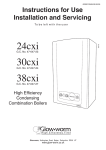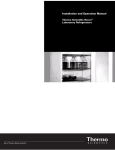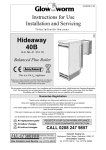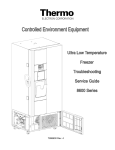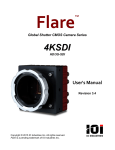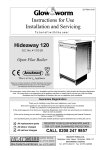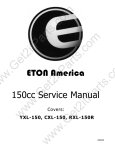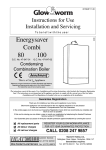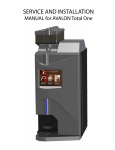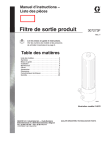Download Compact75E_UIS
Transcript
221895A.04.01 Instructions for Use Installation and Servicing 7086 To b e l e f t w i t h t h e u s e r COMPACT 75e G.C. No. 47 047 06A Fanned Flue Combination Boiler This is a Cat I2H Appliance The instructions consist of three parts, User, Installation and Servicing Instructions, which include the Guarantee Registration Card. The instructions are an integral part of the appliance and must, to comply with the current issue of the Gas Safety (Installation and Use) Regulations, be handed to the user on completion of the installation. Guarantee Registration Thank you for installing a new Glow-worm appliance in your home. Glow-worm appliances' are manufactured to the very highest standard so we are pleased to offer our customers' a Comprehensive First Year Guarantee. In the centre pages are to be found your Guarantee Registration Card, which we recommend you complete and return as soon as possible. If this card is missing you can obtain a copy or record your registration by telephoning the Heatcall Customer Service number 01773 828100. Our Guarantee gives you peace of mind plus valuable protection against breakdown by covering the cost of: ✔ ❑ ✔ ❑ ✔ ❑ All replacement parts All labour charges REGISTER YOUR GLOW-WORM APPLIANCE FOR 1ST YEAR GUARANTEE PROTECTION All call-out charges CALL 0208 247 9857 Customer Services: Tel: (01773) 828100 One Contact Local Service Fax: (01773) 828070 Hepworth Heating Ltd., Nottingham Road, Belper, Derbyshire. DE56 1JT General/Sales enquiries: Tel: (01773) 824141 Fax: (01773) 820569 Important Information Testing and Certification This boiler is tested and certificated for safety and performance. It is therefore important that no alteration is made to the boiler, without permission, in writing, from Hepworth Heating Ltd. Any alteration not approved by Hepworth Heating Ltd., could invalidate the certification, boiler warranty and may also infringe the current issue of the Statutory Requirements, see Section 1.4. CE Mark This boiler meets the requirements of Statutory Instrument No. 3083 The boiler (Efficiency) Regulations, and therefore is deemed to meet the requirements of Directive 92/42/EEC on the efficiency requirements for new hot water boilers fired with liquid or gaseous fuels. Type test for purposes of Regulation 5 certified by: Notified body 0086. Product/production certified by: Notified body 0086. The CE mark on this appliance shows compliance with: 1. Directive 90/396/EEC on the approximation of the laws of the Member States relating to appliances burning gaseous fuels. 2. Directive 73/23/EEC on the harmonization of the Laws of the Member States relating to the electrical equipment designed for use within certain voltage limits. 3. Directive 89/336/EEC on the approximation of the Laws of the Member States relating to electromagnetic compatibility. Substances Hazardous to Health The adhesives and sealants used in this appliance are cured and give no known hazard in this state. INSULATION PADS/CERAMIC FIBRE, GLASSYARN, MINERAL WOOL These can cause irritation to skin, eyes and the respiratory tract. If you have a history of skin complaint you may be susceptible to irritation. High dust levels are usual only if the material is broken. Normal handling should not cause discomfort, but follow normal good hygiene and wash your hands before eating, drinking or going to the lavatory. If you do suffer irritation to the eyes or severe irritation to the skin seek medical attention. SPARE PARTS REMEMBER, When replacing a part on this appliance, use only spare parts that you can be assured conform to the safety and performance specification that we require. Do not use reconditioned or copy parts that have not been clearly authorised by Hepworth Heating Ltd. CONTENTS INSTRUCTIONS FOR USE INSTALLATION INSTRUCTIONS SERVICING INSTRUCTIONS 221895A DESCRIPTION SECTION Introduction Clock Settings Lighting the Boiler PAGE No. 3 4 5 General Data Boiler Position Flue and Ventilation Heating System Domestic Hot Water System Installation Preparation and Gas/Water Connections Flue Preparation Mounting the Boiler Electrical Connections Commissioning 1 2 3 4 5 7 9 10 11 12 6 7 8 9 10 13 13 16 20 22 General Data Servicing Fault Finding Replacement Parts Spare Parts 11 12 13 14 15 25 25 27 32 43 2 Instructions for Use Introduction Alternatively a fused 3A 3 pin plug and shuttered unswitched socket may be used. Please read these instructions and follow them carefully for the safe and economical use of your Combination boiler. The colours of three core flexible cable are, blue - neutral, brown - live, green and yellow - earth. This boiler must have been installed by a competent person in accordance with the current rules in force in the countries of destination at the time of installation. As the markings on your plug may not correspond with these colours continue as follows:The wire coloured blue must be connected to the terminal marked “N” or “Black”. Once the controls are set, the boiler is automatic in operation. The Compact combination boiler is able to provide room heating as part of a central heating system and domestic hot water direct from the cold water supply, without the need for secondary storage. The wire coloured brown must be connected to the terminal marked “L” or “Red”. The wire coloured green and yellow must be connected to the . terminal marked “E” or “Green” or the earth symbol The boiler can be fitted with one of two makes of clock, which look like this:- 6937 Clock / Timers 0 I AUTO RUN P 13 12 11 1 0 19 18 17 1 6 20 7 24 23 22 Digital timer 1 MIN R Note. The boiler safety cutoff may have operated, please refer to the following section to reset. 2 HR 3 21 5 DAY Normal operation of the boiler should resume when the electrical supply is restored. 6 P The boiler will not work without an electrical supply. 4 W Th F S Su 8 M T Electrical Supply Failure I 9 15 14 PVC flexible cable having a conductor size of 0.75mm2 (24/ 0.20mm) must be used within the boiler casing to connect to the boiler. Reset any external controls, to resume normal operation of the central heating. Electro / mechanical clock / timer The digital timer, has a lithium battery back up and will not need resetting. Unless it is without power for a considerable period. IMPORTANT NOTICE: Boiler Safety Cutoff Reset Button This boiler is for use only on G20 gas. The boiler is fitted with a safety cutoff device to prevent damage through overheating. Gas Leak or Fault Should the main burner go out during a demand the red lockout light “F” will illuminate on the control fascia situated above the Reset Button “G”, see diagram 4. If a gas leak or fault exists or is suspected, turn the boiler off and consult your local gas company or your local installation/ servicing company. The red light will not illuminate if there is no system demand. Mains Water Temperature Allow the boiler and system to cool down waiting at least a minimum of four minutes before pressing the Reset button “G”. NOTE: The mains incoming water temperature in the winter is lower than in summer. The boiler will take a few seconds to reset after the button is pressed. To achieve the same outlet water temperature in the winter, it will be necessary to reduce the water flow rate using the hot water tap. If the problem persists, turn the boiler off and consult your installation/ servicing company. Boilers Installed in Compartments If the boiler has been fitted into a compartment or cupboard, do not obstruct the compartment air supply vents. The Gas Safety (Installation & Use) Regulations Do not use the compartment for storage. In your interests and that of safety it is the law that ALL gas appliances are installed by competant persons in accordance with the current issue of the above regulations. Electrical Supply WARNING. The boiler must be earthed. The boiler must be connected to a 230V~50Hz permanent supply. Connection of the whole electrical system of the boiler and any heating system controls to the electrical supply, must be through one common isolator. Isolation should preferably be by a double pole switched fused spur box. The fused spur box should be readily accessible and preferably adjacent to the appliance. It should be identified as to its use. 3 221895A Instructions for Use Setting Instructions for Electro/mechanical Clock - if fitted 3. Set day of week by pressing button DAY. This clock has a twenty four hour dial, that is, 1pm is 13. 5. Set RUN switch to the central position, colon will flash, this indicates the clock is set. 4. Set time of day by pressing buttons HR and MIN. To set the time, turn the whole face clockwise until the pointer is against the time of day. With the clock set, the factory preset programme shown below will operate. To set any “Off” time, push the tappets outwards. To set any “On” time, push the tappets inwards. Setting Timed Programmes Time can be set either “On” or “Off” in fifteen minute segments. With the clock set to the correct time, see SETTING THE CLOCK paragraphs 1-4, and then continue as follows: Note. The clock supplied could be fitted with an override device, see diagram 1, which switches the clock programme “On” or “Off” permanently. 1. Set RUN switch to P , the display will indicate MON/FRI SAT/SUN The switch will need to be repositioned to resume programmed working. CLOCK FACE ON OFF ON OFF - 6938 OVERRIDE SWITCH 0 13 12 11 1 0 2. 19 18 17 1 6 20 4 7 8 6 21 5 POINTER Set day of week to be programmed by pressing the DAY button. An arrow will be displayed under the day or days selected. 2 3. Set time of day by pressing the buttons HR and MIN. 4. Press button P to confirm programmes, the display will indicate the 2nd (OFF) preset programme and subsequently, 3rd, 4th, 5th, 6th, 7th, 8th. 5. Repeat procedures 2, 3 and 4 until desired programmes are set. Diagram 1 Note. It is not a requirement to use the 8 on/off programmes. 1 24 23 22 Setting Instructions for the 7 Day Digital Clock/Timer 6. This is a 24 hour clock/timer, that is 1pm is 13:00, and has 8 “ON” and 8 “OFF” daily switching actions. General Notes. With the AUTO switch in the O position the central heating will not operate. 6939 M T RUN P Set the RUN switch the central position, your appliance will now operate at the programmed times. With the AUTO switch in the I position the central heating will operated constantly ON. It is fitted with a lithium battery back up which protects the programme in the event of an electrical failure. The battery should have a life of several years. I AUTO . Mon-Fri., Mon-Sat., Mon-Sun., Sat/Sun. 3 CONSTANT OFF PROGRAMMED CONSTANT ON 07:00 09:00 16:00 23:00 Note: The days can be selected individually or as groups: TAPPETS 0 I ON OFF ON OFF - the 1st (ON) preset programme and the symbol I 9 15 14 06:30 08:30 16:30 22:30 Soft Override button indicated by the , this function will override the current symbol central heating programme for the next available. W Th F S Su ON time programmes are indicated by the symbol . To Light the Boiler P DAY HR 1. Check that all four isolating valves are open, the levers in line with the valve body, see diagram 3. MIN R 2. Open the controls cover door and familiarize yourself with the controls, see diagram 4. Diagram 2 3. CAUTION. A sealed pressurised system must be filled and pressurised by a competent person. (Optional extra filling loop kit No. 457120). Setting the Clock - Diagram 2 1. With both AUTO and RUN switches set to the central position, press R reset button, the display will flash. 2. Set RUN switch to 221895A Only operate the boiler when you are sure that the system has been filled and pressurised. Check this by looking at the pressure gauge “A”, it should read 0.7bar minimum. . 4 Instructions for Use 4. Open a hot water tap, check that water flows, then close it. Summer / Winter Selector Button 5. If you are in any doubt about the boiler being filled with water contact your installation/servicing company or the local gas company. Adjust the central heating water temperature control knob “N” to desired setting. 6. Check that the electrical supply to the boiler is ON at the external isolator. For central heating set button “J” to Winter light “K” will illuminate. The main burner will light. The burner ON light “D” will illuminate. 7. Check lockout light, refer to boiler safety cutoff reset button. When the heating is controlled by a room thermostat and/or a time switch, button “J” must be set to Winter light “K” will illuminate. 8. Set the switch “B” to 1 situated on the control fascia. 9. Set the summer / winter button “J”, light “L” or “K” will illuminate. If a hot water tap is opened while the boiler is on for heating, priority will be given to hot water. 10. Set “C”, clock/timer (if fitted) and any remote controls as required. To turn the heating off for short periods, set button “J” to summer “Off” light “L” will illuminate. 11. Check the lights “D” and “E” are illuminated on the control fascia. To turn on again set button “J” to winter “On”, light “K” will illuminate. Close the controls cover door. In certain circumstances, a surge in water pressure may cause the appliance to operate momentarily, this will be indicated by the pump starting and the fan speed increasing. This is quite normal. To Turn the Boiler Off Domestic Hot Water Temperature Maintenance and Servicing The sanitary water temperature control knob “M”, see diagram 4, will control the desired temperature of the water until the flow exceeds the capability of the boiler to give the required temperature rise. To ensure the continued efficient and safe operation of the appliance it is recommended that it is checked and serviced as necessary at regular intervals. The frequency of servicing will depend upon the particular installation conditions and usage, but in general once a year should be enough. To turn the boiler off, set switch "B" to O. To turn on again follow the operating instructions. Then the temperature is determined by controlling the hot water flow from the tap ie: reduce flow - increase temperature increase flow - reduce temperature If this appliance is installed in a rented property there is a duty of care imposed on the owner of the property by the current issue of the Gas Safety (Installation and Use) Regulations, Section 35. NOTE : The mains incoming water temperature in the winter is lower than in the summer. 7013 SAFETY VALVE DISCHARGE PIPE POSITION Servicing/maintenance should be carried out by a competent person in accordance with the rules in force in the countries of destination. To obtain service, please call your installer or Heatcall (Glowworm’s own service organisation) using the telephone number behind the controls cover door. Please be advised that the ‘Benchmark’ logbook should be completed by the installation engineer on completion of commissioning and servicing. All CORGI Registered Installers carry a CORGI ID card, and have a registration number. Both should be recorded in your boiler Logbook. You can check your installer is CORGI registered by calling CORGI direct on :- 01256 372300. HEATING FLOW Clearances HEATING COLD GAS HOT RETURN WATER SERVICE WATER SUPPLY IN COCK OUT The boiler requires a clearance in front, below and at the sides of the casing for safety, servicing and maintenance access, see diagram 2.1. Protection Against Freezing The boiler has a 2 stage built in frost protection. Provided power and gas are available and there is adequate pressure in the system, if the water temperature within the appliance falls below 10oC approx. the pump only will come on. If the water temp continues to fall to 6oC approx. the main burner will fire at min rate until the water in the appliance is greater than 15oC approx. This is a separate function to any remote frost protection fitted. LEVER (OPEN) HEATING FLOW/ RETURN LEVER (OPEN) COLD WATER SUPPLY IN/OUT SLOT (OPEN) GAS SERVICE COCK Diagram 3 5 221895A Instructions for Use 6941 CONTROLS FASCIA PRESSURE GAUGE ‘A’ SUMMER/ WINTER BUTTON ‘J’ ‘F’ RESET BUTTON ‘G’ ‘L’ SANITARY WATER TEMPERATURE CONTROL KNOB ‘M’ CLOCK TIMER IF FITTED ‘C’ ‘P’ ‘H’ ‘D’ ‘Q’ ‘K’ ‘E’ CENTRAL HEATING WATER TEMPERATURE CONTROL KNOB ‘N’ MAINS ELECTRIC SWITCH ‘B’ ‘F’ BOILER LOCKOUT ‘H’ LOW WATER PRESSURE ‘L’ SUMMER SETTING ‘K’ 7565 KEY TO NEON LIGHTS WINTER SETTING ‘D’ BURNER IGNITED ‘E’ POWER ‘ON’ ‘P’ SANITARY DEMAND ‘Q’ CENTRAL HEATING DEMAND CONTROLS COVER Diagram 4 Cleaning Other system pipework external to the boiler may require frost protection. WARNING. This appliance contains metal parts (components) and care should be taken when handling and cleaning with particular regard to edges. If the boiler is to be out of use for any long periods during severe weather, it is recommended that the whole system, including the boiler, should be drained to avoid the risk of freezing. Make sure that, if fitted, the immersion heater in the cylinder is switched off. The boiler casing can be cleaned using a mild liquid detergent with a damp cloth, then a dry cloth to polish. Do not use any form of abrasive or solvent cleaner as you may damage the paint work If in doubt, contact you installation/servicing company for advice. Draining and Filling Boiler Casing CAUTION. This boiler works in a pressurised system which must only be drained, refilled and pressurised by a competent person. CAUTION. Do not remove or adjust the casing in any way, as incorrect fitting may result in incorrect operation or failure to operate at all. If in doubt seek advice from the local gas company or your installation/servicing company. Note: If the pressure gauge indicates a loss of system pressure, that is, less than 0.7bar, YOU MUST CONTACT YOUR INSTALLER. Replacement Parts If replacement parts are required apply to your local supplier or British Gas. Pressure Relief Safety Valve CAUTION. A pressure relief safety valve and discharge pipe is fitted to the boiler. This valve must not be touched. Should there be any discharge from the pipe, turn the boiler off, isolate from the electrical supply and contact your installation/servicing company. 221895A Please quote the name of the appliance. 6 1 General Data C E 6942 D Optional flue kits are available Horizontal top outlet and Vertical. P M N CL D F CL G E B 9mm H K K L J A Diagram 1.1 A B C D E F G H J K L 450 700 300 100 75 138 142 18 135 65 110 M N 138 85 P 115 103 STD/EXD. EASYFIT TABLE 1 1.1 Installation Lift Weight 31.7kg (69.89b) Total Weight 41.1kg (90.61lb) Materials and equipment should be fit for their purpose and of suitable quality and workmanship. 1.2 Important Notice Gas connection Ø 15mm compression Heating and return Ø 22mm compression Domestic hot water Ø 15mm compression 1.3 Sheet Metal Parts Safety valve Preset 3bar (43.5lbf/in2) Safety valve discharge Ø 15mm copper WARNING. When installing or servicing this boiler care should be taken when handling the edges of sheet metal parts to avoid any possibility of personal injury. Water content 1.42 litres (0.31 gallon) This boiler is for use only on natural gas, G20. 1.4 Requirements ■ Expansion vessel capacity 6 litres (1.32 gallons) Heating cold fill pressure minimum ❋ D.H.W The installation of this boiler must be carried out by a competent person in accordance with the rules in current force in the countries of destination at the time of installation. 0.7bar (10.1lbf/in2) 0.8 to 10bar Manufacturer’s instructions, supplied. working pressure ■ Maximum Heating Manufacturer’s instructions must not be taken as overriding statutory requirements. system water content using fitted expansion vessel. 60 litres (13.2 gallons) with a cold fill pressure of 0.7bar Electrical supply 230V~50Hz Electrical rating 150W fused 3A 1.6 Data Internal Fuse rating 1) Type T2A See table 1 and diagram 1.1, 1.2 & 1.3. 1.5 Data Label The data label is on the inner case front, see diagram 1.2. The Seasonal Efficiency Domestic Boilers UK (SEDBUK) is 77.4%. ❋ Boiler starts at an inlet pressure of 0.5bar but requires 0.8bar for maximum output. ■ For larger systems use an additional expansion vessel, see Section 4. Approximate gas rate at max input The value is used in the UK Government’s Standard Assessment Procedure (SAP) for energy rating of dwellings. The test data from which it has been calculated have been certified by B.S.I. 2.33m3/h (82.23ft3/h) 7 221895A 1 General Data 1.7 Gas Supply Thermostatic radiator valves may be installed, however they must not be fitted in a room where the room thermostat is located. The gas installation shall be in accordance with the rules in force in the countries of destination. Note: All systems must have at least one radiator not fitted with a thermostatic valve. The supply from the governed meter must be of adequate size to provide a steady inlet working pressure of 20mbar (8in wg) at the boiler. With all other appliances operating. 1.8 Electrical Supply WARNING. This boiler must be earthed. HEPWORTHHEATINGLTD., BELPER,DERBYS.DE56 1JT All system components shall be of an approved type. The electrical installation shall be in accordance with the current rules in force in the countries of destination at the time of installation. COMPACT 75E 7525 Note: For further information, see The Building Regulations 1991 - Conservation of fuel and power, 1995 edition - Appendix G, table 4b. 457151 230V~ 50Hz 150W Fused at 3A TYPE : C12 - C32 For use on :I 2H -G20 - 20 mbar NOx Class 3 GC No. 47-047-06A This boiler is intended exclusively 0086 GB IE to be installed on a gas supply with a governed meter 86/AU/587 SPECIFIC WATER RATE 10.52 l/min. DOMESTIC CIRCUIT PMW = 10 bar HEATING CIRCUIT PMS = 2.5 bar G20 DHW MAX. CH MAX. MIN HOT BURNER PRESSURE mbar 14.7 14.7 1.71 Connection of the whole electrical system of the boiler and any heating system controls to the electrical supply, must be through one common isolator. Isolation should be by a double pole switched fused spur box, having a minimum contact separation of 3mm in each pole. The fused spur box should be readily accessible and preferably adjacent to the appliance. It should be identified as to its use. Alternatively, a fused 3A 3pin plug and unswitched socket may be used, provided they are not used in a room containing a bath or shower. HEAT INPUT NETT Q = kW = kW HEAT OUTPUT P SERIALNo. The mains supply cable and other cables connected to the boiler must be the PVC flexible type of at least 0.75mm2 (24/ 0.20mm) . 24.45 21.98 24.45 10.85 21.98 8.79 INJECTOR:4.1mm 205770 The appliance flue type is a C12 and C32. This refers to a concentric flue where the fan is downstream of the heat exchanger. The C12 is a horizontal flue termination, and the C32 is a vertical flue termination. 1.9 Heating System Controls The heating system should have installed: a timer and room thermostat controlling the boiler. FANNED FLUE EXPANSION VESSEL 7641 Diagram 1.2 HEAT EXCHANGER OVERHEAT CUT-OFF LOW WATER PRESSURE SWITCH PRESSURE DIFFERENTIAL MICRO SWITCH MOTORISED 3 WAY VALVE HOUSING TEMP. SENSOR C.H. RETURN 221895A MAIN BURNER GAS VALVE TEMP. SENSOR VALVE PUMP HOUSING D.H.W. MICRO SWITCH PLATE TO PLATE HEAT EXCHANGER SAFETY VALVE BYPASS VALVE D.H.W. HOT OUTLET AUTOMATIC AIR VENT D.H.W. C.H. COLD FLOW INLET GAS 8 SAFETY VALVE DISCHARGE Diagram 1.3 2 Boiler Position 2.1 Location This boiler must be installed in accordance with the rules in force in the countries of destination. 7087 25 ABOVE THE TOP OF THE BOILER CASE OR THE FLUE ELBOW IF FITTED This boiler is not suitable for fitting outside. Any electrical switch must be positioned so that it cannot be touched by a person using the bath or shower. The boiler must be mounted on a flat wall which is sufficiently robust to take its weight, refer to Table 1, “Data”. If the location of the boiler or any part of the system is subject to severe cold weather conditions, it is recommended that a frost thermostat is fitted. Any part of the system that may be vulnerable to freezing must be protected. 5 5 450 2.2 Boilers in a compartment Where the installation of the boiler will be in an unusual position, the current issue of BS6798 gives detailed guidance on these requirements. An existing cupboard or compartment modified for the purpose may be used, providing minimum clearances are maintained. Details of essential requirements for cupboard or compartment design are given in the current issue of BS6798. The door way opening should be of sufficient size to allow for easy removal of the boiler. 150 Where the boiler is fitted in a cupboard or compartment, permanent ventillation is not required. To achieve minimum "Installation" clearance of 5mm. The side panels will have to be fitted prior to boiler mounting. Any existing compartment air vents must not be removed or blocked off. 2.3 Clearances DIMENSIONS IN MILLIMETRES The boiler should be positioned so that at least the minimum operational and servicing clearances are provided, see diagram 2.1. Additional clearances may be required around the boiler for installation. Diagram 2.1 2.4 Timber Frame Buildings If the boiler is to be installed in a timber frame building it should be fitted in accordance with the Institute of Gas Engineers document IGE/UP/7/1998. If in doubt seek advice from the local gas undertaking or Hepworth Heating Ltd. 9 221895A 3 Flue and Ventilation 3.1 General The guard should be similar to that shown in diagram 3.1 . The flue must be installed in accordance with the rules in force in the countries of destination. 3.6 Room Ventilation 3.2 Terminal Position Ventilation must be provided in accordance with the rules in force in the countries of destination. The boiler is room sealed, so where the boiler is fitted in a room or space, a permanent air vent is not required. The minimum acceptable siting dimensions for the terminal from obstructions, other terminals and ventilation openings are shown in diagram 3.1. 3.7 Cupboard/Compartment Ventilation The terminal must be exposed to the external air, the position allowing free passage of air across it at all times. If the boiler is to be fitted in a cupboard or compartment. Refer to Section 2.2. 2816 Car port or similar extensions of a roof only, or roof and one wall, require special consideration with respect to any openings, doors, vents or windows under the roof. Care is required to protect the roof if made of plastic sheeting. If the car port comprises of a roof and two or more walls seek advice from the local gas undertaking before installing the boiler. C A If the terminal is fitted within 600mm below plastic guttering, an aluminium shield 1500mm long should be fitted immediately beneath the guttering or eaves. If the terminal is fitted within 450mm below painted eaves or a painted gutter, an aluminium shield 750mm long should be fitted immediately beneath the guttering or eaves. B,C B,C G A F G F F A E K L K G G L K G UNDER CAR PORT etc. 3.3 Flue Options There are various flue systems to choose from, as follows: Standard Top Outlet Flue Pack - Pt.No. 230483 D J F Easyfit Top Outlet Flue Pack - Pt.No. 232057 K H,I Standard Rear Outlet Flue Pack - Pt.No. 230482 Extended Top Outlet Flue Pack - Pt. No. 230487 1 Metre Extension Kit - Pt. No. 230484 Optional Wall Liner Kit No. 900862 MINIMUM SITING DIMENSIONS FOR FANNED FLUE TERMINALS POSITION A Flue Bend Kit or Vertical Flue Kit can be supplied, see Hepworth Heating "Flue Options Guide" for configurations available. mm A DIRECTLY BELOW, ABOVE OR 45o Flue Bend Pack - Pt. No. 230485 HORIZONTALLY TO AN OPENING, AIR BRICK, OPENING WINDOWS, AIR VENT OR ANY 300 OTHER VENTILATION OPENING. 90o Flue Bend Pack - Pt. No. 230486 B BELOW GUTTER, DRAIN/SOIL PIPE C BELOW EAVES D BELOW A BALCONY OR CAR PORT E FROM VERTICAL DRAIN PIPES AND SOIL PIPES F FROM INTERNAL OR EXTERNAL CORNERS G ABOVE ADJACENT GROUND OR BALCONY LEVEL H FROM SURFACE FACING THE TERMINAL I FACING TERMINALS J FROM OPENING (DOOR/WINDOW) IN CAR PORT INTO DWELLING K VERTICAL FROM A TERMINAL L HORIZONTALLY FROM A TERMINAL In Line Flue Adapter Kit - Pt. No. 230488 Vertical Flue Kit No. 458115 3.4 Internal Access Flue All flue assemblies are designed for internal installation, given that there is sufficient clearances opposite to the flue for the installation of the flue. If there is insufficient clearance the flue can be installed from outside. For a wall thickness up to 300mm, provided that there is sufficient space and the optional wall liner kit is used, the flue can be installed from the inside. For a wall thickness of over 300mm the external flue hole will need to be made good from the outside, this also applies if you use the flue kit without the optional wall liner kit, irrespective of wall thickness. 25 25 25 200 25 25 300 600 1200 1200 1500 300 TERMINAL GUARD TYPE K3 SUPPLIED BY : Tower Flue Components Ltd. Morley Road Tonbridge Kent TN9 1RA Diagram 3.1 3.5 Terminal Guard A terminal guard is required if persons could come into contact with the terminal or the terminal could be subject to damage. If a terminal guard is required, it must be positioned to provide a minimum of 50mm clearance from any part of the terminal and be central over the terminal. 221895A MINIMUM SPACING 10 30 Remaining conveying capacity (mH20) 6.0 Dt at 75000 btu output Dp (M H2O) 5.0 25 4.0 20 3.0 15 2.0 10 1.0 5 0.0 0 5 15 10 20 25 9093 4 Heating System 0.0 30 Circuit flow (l/min) Diagram 4.1 4.1 General Notes 4.7 Bypass The boiler is intended for use in a sealed system only. The bypass is an integral part of the boiler. 4.2 Safety Valve 4.8 Filling Sealed Systems The safety valve is an integral part of the boiler. An optional extra filling loop is available Part No. 457120 Provision for filling the system at a low level must be made. Three methods of filling are shown in diagram 4.3. It cannot be adjusted but has a manual test device. 4.3 Pressure Gauge There must be no permanent connection to the mains water supply, even through a non-return valve. A pressure gauge is incorporated into the boiler to indicate the system pressure. NOTE: It is important that fittings used for connection to potable water comply with the water undertakers requirements. The gauge has a cold fill set pointer. 4.9 Corrosion Inhibitor 4.4 Pump If an inhibitor is to be used in the system, contact the inhibitor manufacturer so that they can recommend their most suitable product. The circulation pump is integral with the boiler. The remaining circulating pressure head available from the boiler is shown in diagram 4.1, Glow-worm pump. When fitting the boiler into an existing system, special care should be taken to drain the entire system, including radiators, then thoroughly cleaning out before fitting the boiler whether or not adding an inhibitor. 4.5 Expansion Vessel The boiler has an integral expansion vessel with a capacity of 6 Litres. If the system water content exceeds the maximum quoted in Table 1, Data, an additional vessel should be connected into the system as close as possible to the central heating return connection of the boiler, see diagram 4.2. 4.10 Draining A draining tap must be provided at the lowest points of the system, which will allow the entire system to be drained. An additional draining tap MUST be fitted close to the boiler. The charge pressure shall not be less that the static head at the point of connection, that is, the height of the top point of the system above the expansion vessel. The flow and return isolation valves are provided with drain points for boiler heat exchanger drainage. 4.6 Flow Rate A valve must be incorporated in the main flow or return of the system, valve “A” shown in the flow diagram 4.2. This valve must be lockable and positioned so that inadvertent closure or unauthorised interference is not possible. The design differential can be between 11°C (20°F) and 17°C (30°F), dependent upon the system resistance and the available pump head. 11 221895A 4 Heating System ADDITIONAL EXPANSION VESSEL (if required) 6951 METHOD 1 COMBINED CHECK VALVE AND VACUUM BREAKER TEMPORARY HOSE SERVICING VALVE HOSE UNIONS SUPPLY PIPE OPTIONAL FILLING KIT AVAILABLE No. 457120 SUPPLY STOP VALVE METHOD 2 HEATING DOUBLE CHECK SYSTEM VALVE ASSEMBLY TEMPORARY HOSE FILLING POINT HEATING SYSTEM 3132 HOT BOILER ALTERNATIVE METHODS OF FILLING COLD SUPPLY DOMESTIC WATER RETURN HEATING CIRCUIT HOSE UNIONS ’A’ FLOW CONTROL VALVE DRAIN POINT SUPPLY PIPE SERVICING VALVE SUPPLY STOP VALVE METHOD 3 Diagram 4.2 CISTERN OVERFLOW HEATING SYSTEM PRESSURE SERVICING REDUCING VALVE VALVE SUPPLY STOP VALVE SUPPLY PIPE HOSE UNIONS DOUBLE CHECK VALVE ASSEMBLY Diagram 4.3 5 Domestic Hot Water System 5.1 General 5.3 “Hard” Water Areas The domestic hot water service must be in accordance with the rules in force in the countries of destination. In areas where the water is “hard”, more than 200mg/litre, it is recommended that a proprietary scale reducer is fitted in the cold water supply to the boiler. Consult the local water company for additional advice. 5.2 Water Pressure A double check valve assembly must be fitted upstream of the scale reducer. For the relative position of the scale reducer and pressure reducing valve, if required, refer to the manufacturer’s instructions. For the minimum and maximum working pressures of the domestic hot water circuit of the boiler refer to diagram 1.2. If the cold water supply pressure exceeds the maximum, a governor must be fitted in the supply to the boiler to reduce the pressure to within the limits given. 221895A 12 6 Installation Preparation and Gas / Water Connections The installation requires the following components :Plumbing jig Carton 2. Boiler Carton 3. Flue Pack SAFETY DISCHARGE PIPE ROUTING POSITION 6956 1. 6.1 Plumbing Jig Remove from the wall template, then follow the instructions given on the template. Note: Leaving the service cock bracket (lower jig) fixing screws loose will make the fitting of the boiler service elbows on to the service cocks easier. Once the service connections are made, tighten service cock bracket (lower jig) fixing screws. It is important that the wall hanging bracket and the service cock bracket (lower jig) are fitted to a flat and true wall area for correct alignment with the boiler. If this cannot be achieved it is acceptable to pack out the service cock bracket (lower jig) to obtain the correct alignment with the wall hanging bracket. HEATING FLOW HOT WATER OUT COLD GAS SERVICE WATER SUPPLY COCK IN HEATING RETURN 6.2 Gas Connection Provision is made for the gas supply to be connected from below the boiler, see diagrams 1.1 and 6.1 for position. Refer also to “Gas Supply”, Section 1.7. LEVER (OPEN) HEATING FLOW/ RETURN Make the gas supply connection to the gas service cock. While making the connection, do not subject the gas service cock to heat as you may damage the seals. LEVER (OPEN) COLD WATER SUPPLY IN/OUT SLOT (OPEN) GAS SERVICE COCK Diagram 6.1 6.3 Water Connections 6.4 Safety Valve Discharge Provision is made for the domestic cold water inlet to be connected from below or through an internal wall at the rear of the boiler, see diagram 1.1 and 6.1 for position. WARNING. It must not discharge above an entrance or window or any type of public access area. A short discharge pipe is supplied loose with the boiler, which when fitted to the safety valve, will end below the boiler the position is next to the heating return, for position see diagram 6.1. Refer also to Section 5 “Domestic Hot Water System”. Provision is made for the water connections to be connected from below or from above, passing down either side of the boiler. Take care that any pipework connected from above will clear the expansion vessel. Refer to the wall template. If connecting from above a vertical piping kit 457160 is available and is recommended. If necessary, temporarily fit the boiler. This must be extended, using not less than 15mm od metal pipe, to discharge, in a visible position, outside the building, facing downwards, preferably over a drain. The pipe must have a continuous fall and be routed to a position so that any discharge of water, possibly boiling, or steam cannot create any danger to persons, damage to property or external electrical components and wiring. Flush out the domestic water and heating system before connecting the boiler. Note. To ease future servicing it is advisable to use a compression type fitting to extend the discharge pipe. NOTE: Top rear flue outlet is not possible with a vertical piping kit. Make the connections to the domestic hot water outlet and the heating system by means of the isolating valves, see diagram 6.1. While making the connections. Do not subject any of the isolating valves to heat as you may damage the seals. Make sure that the drain and operating screw heads on the isolating valves are accessible. 13 221895A STD/EXTD 'X' plus 254mm (RH) = flue length 'X' plus 10mm (LH) = flue length TOP OUTLET FLUE PACK FLUE LENGTH MAX 840mm (extd.) MAX 570mm (std/easyfit) 5mm* EASYFIT 'X' plus 282mm (RH) = flue length 'X' plus 38mm (LH) = flue length 54mm* (must include 50mm min. side clearance) 239mm* TOP OUTLET/ SIDE FLUE FLUE LENGTH MAX 840mm (extd.) MAX 570mm (std/easyfit) 15mm SCREW & TAPE 'X' 9377 7 Flue Preparation TOP OUTLET/ REAR FLUE 15mm SCREW & TAPE 'Y' STD/EXTD 'Y' plus 69mm = flue length EASYFIT 'Y' plus 97mm = flue length *STD/EXTD flue only EASYFIT/STD./EXTD. TOP OUTLET FLUE PACK & 1 METRE EXTENSION SCREW & TAPE 2 x 1 metre extension kits may be joined together. 15mm VIEW 'B' SCREW & TAPE SCREW & TAPE 'Y' 'X' SIDE FLUE STD/EXTD 'X' plus 254mm (RH) = flue length 'X' plus 10mm (LH) = flue length EASYFIT: 'X' plus 282mm (RH) 'X' plus 38mm (LH) = flue length REAR OUTLET FLUE PACK VIEW 'B' REAR FLUE STD/EXTD 'Y' plus 69mm = flue length EASYFIT 'Y' plus 97mm = flue length REAR OUTLET FLUE PACK & 1 METRE EXTENSION KIT FLUE LENGTH 510mm MAX. 2 x 1 metre extension kits may be joined together. 80mm FOAM SEAL 'Y' SCREW & TAPE 'Y' plus 95mm = FLUE LENGTH SCREW & TAPE 80mm FOAM SEAL 'Y' MAXIMUM DISTANCE FROM MAXIMUM "Y" "X" FLUE BOILER MOUNTING FACE BOILER CASING TO LENGTH MINIMUM FLUE LENGTH TOP STD/ EASYFIT REAR SIDE R.H. SIDE L.H. 75 75 75 144 334 90 570 570 570 500 - 316 560 TOP EXTD. REAR SIDE R.H. SIDE L.H. 75 75 75 144 334 90 840 840 840 770 - 586 830 REAR STD. REAR 75 170 510 415 - 221895A SCREW & TAPE 'Y' plus 95mm = FLUE LENGTH MINIMUM WALL THICKNESS FLUE PACKS 15mm TO EXTERNAL WALL FACE EXTERNAL WALL FACE 14 NOTE : IF IT IS NECESSARY TO CUT THE DUCTS TO ACHIEVE THE "FLUE LENGTH" MAKE SURE THAT THE OVERLAPS ARE AS FOLLOWS :THE OVERLAP FOR AIR DUCT = 25mm THE OVERLAP FOR FLUE DUCT = 50mm 9358 15mm THE MAXIMUM LENGTHS CAN BE INCREASED BY AN ADDITIONAL 2 METRES WITH THE USE OF THE 1 METRE EXTENSION KITS. NOTE :THIS APPLIES TO STANDARD KITS ONLY. Diagram 7.1 7 Flue Preparation 7148 7.1 Flue Position and Length Determine flue application, length and terminal position before starting, refer to diagram 7.1. Note: The Standard Top Outlet Flue Pack, Easyfit Top Outlet Flue Pack and the Extended Top Outlet Flue Pack contains a flue duct extension piece complete with "O" rings, this should be discarded. If you are using a Flue Bend or a Vertical Flue Kit, please follow the instructions supplied with the kit. OPTIONAL FLUE COLLAR To make a neat finish to the flue outlet a flue collar kit, part No. 443286, with instructions, is available, see diagram 7.2. Diagram 7.2 Note: If required an optional wall liner kit, part no. 900862, is available complete with instructions. 7102 WITH WALL LINER KIT ONLY 7.2 Flue Assembly WALL THICKNESSUP TO 300mm Extend the telescopic flue to the required length, making sure that the minimum overlap is no less than 25mm, and that the flue terminal projects 15mm minmum beyond wall face, see diagram 7.1. FOAM SEAL Carefully drill though air duct pilot hole and secure with self tapping screw provided in fittings pack, see diagram 7.1. Seal the joint with the tape provided. Q If the flue system requires the addition of flue extension kits, drill, seal and secure them with the self tapping screw and tape provided. 15mm Note: Should any one of the flue sections require cutting to obtain desired flue system length, cut at the end opposite the expanded end. FOAM SEAL Q-35mm If the boiler is not to be fitted for some time cover the hole in the wall. 7.3 Internal Access Flue If access to the outside wall is not practical, the flue system can be installed from inside. Use of the optional wall liner kit is required. Q 7.4 Rear Outlet Flue Fixing Fit the self adhesive foam seal provided in the flue pack around the air duct at the position shown in diagram 7.1. WALL THICKNESSOVER 300mm Diagram 7.3 Make good around the flue outside after installation of the boiler. Important: If the wall liner kit is used, the self adhesive foam seal included in the wall liner kit must be used in place of the one supplied with the flue pack, see diagram 7.3 for position of self adhesive seal. 7.5 Top Outlet Side or Rear Flue Fixing Make good the area around the flue inside and outside after installation of the boiler. Important: If the wall liner kit is used, the self adhesive foam seal included in the wall liner kit must be used in place of the one supplied with the flue pack, see diagram 7.3 for position of self adhesive seal. 7.6 Flue Positioning Push the flue assembly into and through the hole such that it is within the wall, and does not stick out into the room. Do not push the flue assembly too far into the hole as it has to be pulled back into the boiler and secured. 15 221895A 8.1 Boiler Mounting Remove the inner case front, secured by two clamps at the bottom lift up and unhook from the threaded lugs at the top, see diagram 8.1. RETAINING LUG (4) COMBUSTION CHAMBER PANEL 7011 8 Mounting the boiler Remove the combustion chamber panel transit screws, see diagram 8.2. (It will not be necessary to refit these). Slide the combustion chamber panel upwards to disengage from the retaining lugs, pull forward to remove, see diagram 8.2. Remove the fan electrical connections by pulling the plastic boots not the wires. Remove the tubes from fan, noting the colour tubes positions. see diagram 8.3. Remove the fan and flue collector assembly by pulling it forward see, diagram 8.3. Remove the rear outlet restrictor plate and retain if using the rear flue outlet, see diagram 8.4. REAR FLUE ONLY Fit the flue spigot supplied seperately, see diagram 8.5. TRANSIT SCREW (2) Diagram 8.2 CLEAR Note: Should the side clearances be less than 30mm. It will be necessary to fit the side panels before mounting the boiler. Refer to Section 10.10 for fitting. AIR PRESSURE TUBE (3) Remove the protective caps from the boiler water pipes. Fit the sealing washers (supplied in the fittings pack) to the boiler water pipes by inserting them into the tubing nuts (the nipples on the washers will hold them in position), see diagram 8.8. RED ELECTRICAL CONNECTIONS 6965 Lift the boiler into position on the top mounting brackets use hand holes provided, see diagram 8.6. SECURING CLAMP (2) 6984 TOP FLUE ONLY Remove the blanking plate from the top of the boiler and use to blank the hole where the rear restrictor plate (discard) was fitted. RETAINING LIP AT REAR FAN INNER CASE FRONT Pull Forward THREADED LUG (2) 221895A Diagram 8.1 Diagram 8.3 16 8 Mounting the boiler 6955 8.2 Water and Gas Connections RETAINING LUG Locate the boiler water pipes and gas supply pipe making sure the washers are retained in the tubing nuts onto the isolation valves, fully push the boiler back, see diagram 8.8. BOILER Ensure the bottom boiler bracket is sitting on top of the service cock bracket, see diagram 8.6. Secure all the tubing nuts finger tight, plus 3/4 turn maximum. Connect the gas pipe to the isolation valve ensuring that the sealing washer (supplied fitted) is in position. 8.3 Boiler Securing Secure the boiler to the service cock bracket with the screws provided in the fittings pack, see diagram 8.6. TOP MOUNTING BRACKET An anti theft kit is available, Kit No. 457110. 8.4 Discharge Pipe Fit the short discharge pipe to the safety valve using the nut and sealing washer supplied in the fittings pack, see diagram 8.9. Extend the discharge pipe, using only a compression type fitting to join the discharge extension, refer also to Section 6.4 “Safety Valve Discharge”. 8.5 Rear Outlet Flue Fixing Make sure that the ductings do not slope down towards the boiler. 7644 RESTRICTOR PLATE AIR PRESSURE SWITCH HAND HOLES SECURING SCREW (3) GASKET FLUE SPIGOT 7304 Diagram 8.4 SECURING SCREW (3) BOILER BRACKET (On Top) SERVICE COCK BRACKET SECURING SCREW Diagram 8.5 Diagram 8.6 17 221895A 8 Mounting the boiler Fit the air duct into the flue spigot by pulling the air duct into the flue spigot, locating cutouts. Turn the air duct anti-clockwise to lock into the cutouts, see diagram 8.10. 8.6 Top Outlet Side or Rear Flue Fixing Position the restrictor plate supplied in the loose items pack, between the flue elbow and boiler , (gasket facing upwards). Fit the flue elbow to the restrictor plate and top of the boiler using the four screws supplied, see diagram 8.7. Note: It is important the correct restrictor plate is fitted or refitted, see restrictor table. Fit the flue connecting sleeve onto the fan, see diagram 8.11. Fit the fan to the flue ducting, see diagram 8.11. Tighten the four screws of the flue elbow evenly to ensure a good seal at the gasket. Fit the fan and flue collector the electrical connections and air pressure tubes to the fan. Note: It is important the correct restrictor plate is fitted or omitted where instructed. Refit the combustion chamber panel. For top flue outlet be sure to use the correct restrictor plate, all restrictors are supplied with the appliance, see restrictor table. DISCHARGE PIPE 7405 SECURING SCREW (4) FLUE ELBOW (REAR FLUE SHOWN) 7022 Make the outer wall weatherproof. A Flue Collar Kit Part No. 443286 is available. PRESSURE GAUGE CONNECTION PRODUCTS PROBE RESTRICTOR/ GASKET SAFETY VALVE DISCHARGE SEAL UNION CONNECTION 8080 Diagram 8.7 FITTED TO HYDRO BLOCK GAS SUPPLY DISCHARGE PIPE 7305 Diagram 8.9 SERVICE COCKS (4) AIR DUCT TUBING NUT FLUE SPIGOT SEALING WASHER (4) (INSERT INTO TUBING NUT) 221895A TAB (2) CUTOUT (2) Diagram 8.8 Diagram 8.10 18 9404 8 Mounting the boiler RESTRICTOR TABLE FLUE OUTLET CASE REAR CASE REAR TOP LHS TOP RHS TOP REAR MAX FLUE LENGTH RESTRICTOR PLATE UP TO 0.5m 0.5m TO 2.5m UP TO 2.5m UP TO 2.5m UP TO 2.5m F G C C C Make sure that the ductings do not slope down towards the boiler. Secure the fan to the flue collector with the securing screw and retaining lip, see diagram 8.14. Remove the fan from the flue collector, secured with a screw and retaining lip. Fit the electrical connections and air pressure tubes to the fan. Refit the combustion chamber panel. Fit the flue connecting sleeve onto the fan, see diagram 8.12. Make the outer wall weatherproof. A Flue Collar Kit Part No. 443286 is available. 7307 Fit the fan to the flue ducting, Holding it up in position fit the flue collector, see diagram 8.13. FLUE DUCTING RETAINING LIP FLUE CONNECTING SLEEVE 7308 FLUE CONNECTING SLEEVE FLUE DUCTING FAN (Push up to fit) FAN FLUE COLLECTOR Diagram 8.11 CLEAR ELECTRICAL CONNECTIONS 7306 FLUE DUCTING Diagram 8.13 7404 RED AIR PRESSURE TUBE (2) Push to fit FLUE CONNECTING SLEEVE FLUE CONNECTING SLEEVE FAN Diagram 8.12 19 FAN SECURING SCREW RETAINING LIP Diagram 8.14 221895A 9.1 Supply Cable Connection CAUTION: To prevent an induced current from switching the central heating on, when not required, it is important that the heating system control cables are separated from the other mains supply cables. CONTROLS FASCIA SECURING SCREW (2) 6964 9 Electrical Connections Open the controls cover door. Remove the two screws securing the controls facia, see diagram 9.1. Hinge the control fascia open. The boiler requires a permanant mains supply through an external isolator which must also isolate any heating system controls, see diagram 9.2. Any heating system controls must not interrupt the permanent mains supply to the boiler. Using PVC cable of a suitable length and rating as stated in Section 1.8 “Electrical Supply”, route the mains supply cable and connect to the appropriate terminals of the connector block, restrain with the cable clamp supplied, see diagram 9.2. CONTROLS COVER Diagram 9.1 Make the earth cable of a greater length so that if the cable is strained the earth would be the last to become disconnected. CAUTION: It is ESSENTIAL to make sure that the polarity is correct. RED LINK CONNECTION BLOCK 9.2 Heating System Controls All external controls and wiring are required to provide a minimum of reinforced insulation at 250Vrms between the parts of those devices operating at mains hazardous voltage and the user accessible parts af those devices. CABLE CLAMP 7024 Standard colours are, Brown - Live, Blue - Neutral, Green and Yellow - Earth. GROMMET R2 R1 Note: For further information, see The Building Regulations 1991 - Conservation of fuel and power, 1995 edition - Appendix G, table 4b. N If electrical controls are not to be used to regulate the heating system, do not remove the red link cable. L When any form of external electrical control is being used to regulate the heating system, remove the red link cable and connect heating system controls in series. The mains cable outer insulation must not be cut back external to the plug. SCREW (2) 9.3 Clock/timer Kit (if applicable) MAINS CABLE Fit the clock/timer kit following the appropriate sections of the instructions supplied with it.. 9.4 Frost Thermostat If the installation requires protection by a “frost thermostat”, connect a single pole type, to the appropriate terminals of the connector. Keep all cables away from hot surfaces. 9.5 Electrical Test Carry out preliminary electrical system checks as below: 1. Test insulation resistance to earth of mains cables. 2. Test earth continuity and short circuit of all cables 3. Test the polarity of the mains. Refit the control fascia. Diagram 9.2 221895A 20 EXTERNAL CLOCK TO BOILER RED LINK. REMOVE WHEN CONNECTING ANY HEATING SYSTEM CONTROLS 5 WAY TERMINAL BLOCK INTEGRAL CLOCK (N) (R1) TO BOILER 5 WAY TERMINAL BLOCK (L) (L) 7100 9 Electrical Connections (N) (R1) (R2) (R2) RED LINK MAINS POTENTIAL FROST STAT. SWITCH CONTACTS CLOCK JUNCTION BOX TIME CONTROL 3 AMP FUSE L JUNCTION BOX E 230V~50Hz DOUBLE PERMANENT MAINS POLE N SUPPLY ISOLATOR 230V~50Hz FROST STAT. NO ROOM STAT. INTEGRAL CLOCK TO BOILER 5 WAY TERMINAL BLOCK 3 AMP FUSE DOUBLE POLE ISOLATOR 230V~50Hz PERMANENT MAINS SUPPLY L (L) (N) (R1) (R2) ROOM THERMOSTAT N MAINS POTENTIAL FROST STAT. FROST THERMOSTAT E ELECTRICITY SUPPLY CONNECTIONS INTEGRAL CLOCK TO BOILER JUNCTION BOX MAINS POTENTIAL ROOM STAT. 5 WAY TERMINAL BLOCK 3 AMP FUSE (L) (N) (R1) (R2) L 3 AMP FUSE L DOUBLE POLE ISOLATOR E 230V~50Hz PERMANENT MAINS N SUPPLY 230V~50Hz PERMANENT MAINS DOUBLE N SUPPLY POLE ISOLATOR RED LINK. REMOVE WHEN CONNECTING SYSTEM CONTROLS 230V~50Hz 230V~50Hz FROST STAT. ROOM STAT. USED AS LINK MAINS POTENTIAL ROOM STAT. JUNCTION BOX E RED LINK. REMOVE WHEN CONNECTING SYSTEM CONTROLS INTEGRAL CLOCK TO BOILER 5 WAY TERMINAL BLOCK 230V~50Hz ROOM STAT. NO FROST STAT. (L) INTEGRAL CLOCK (N) (R1) TO BOILER 230V~50Hz POTENTIAL FROST STAT. 5 WAY TERMINAL BLOCK (L) (N) 3 AMP FUSE L DOUBLE N POLE ISOLATOR (R2) (R1) (R2) JUNCTION BOX E 230V~50Hz PERMANENT MAINS SUPPLY 3 AMP FUSE POTENTIAL FREE ROOM STAT. RED LINK. REMOVE WHEN CONNECTING SYSTEM CONTROLS L 230V~50Hz DOUBLE PERMANENT MAINS POLE N SUPPLY ISOLATOR 230V~50Hz ROOM STAT. POTENTIAL FREE ROOM STAT. NO FROST STAT. E 230V~50Hz POTENTIAL ROOM STAT. RED LINK. REMOVE WHEN CONNECTING SYSTEM CONTROLS 230V~50Hz FROST STAT. Diagram 9.3 21 221895A 10 Commissioning Please ensure the “Benchmark” logbook is completed and left with the user. The burner pressure is factory preset and no adjustment should be required. 10.1 Filling Domestic Water Circuit Check the burner pressure is within +/-0.2mbar. of 14.7mbar. If this is incorrect, the burner pressure may be adjusted to the correct setting by turning the hot water gas pressure adjuster (potentiometer), located on the control board. To gain access remove the two screws securing the controls facia, see diagram 9.1. Check that the boiler is isolated from the electrical supply, at the external isolator. Fully open the domestic water supply stop cock or valve in the supply to the boiler. Hinge the control facia forward. Open the inlet domestic water isolation valve, lever in line with the valve body, see diagram 6.1. Remove the plastic plugs. Using the burner adjusting tool supplied. (clockwise to increase), see diagram 10.2. Turn the adjuster slowly, always making adjustment by reducing below the required pressure then increasing up to the required setting. Open all hot water draw-off taps and close them when water flows. Check for water soundness of the whole domestic water system and boiler. Close the hot water draw off. 10.2 Filling the Heating System If the maximum pressure cannot be obtained, check that the gas supply of adequate size, refer to Section 1.7. Open the two central heating isolating valves, levers in line with the valve body, see diagram 6.1. 10.5 Gas Rate Modulation Flush, fill and vent the system refer to Section 4.8 “Filling Sealed Systems”. The burner pressures are factory preset and no adjustment should be required. WARNING. SEVERAL COMPONENTS OPERATE ON MAINS VOLTAGE AND WITH THE OUTER CASE REMOVED, LIVE COMPONENTS BECOME EXPOSED. When checked if they are not consistant with the information in table 1. the following steps should be taken. Fully open a domestic hot water tap ensure there is no modulation. Turn the domestic burner pressure potentiometer to minimum by turnining anticlockwise with the tool supplied (do not force it), see diagram 10.2. Make sure that the automatic air vent is operating correctly. Take care not to splash any of the electrical components. Open the controls cover. Carefully turn the minimum stop screw on the gas control valve. When the correct setting is achieved adjust the potentiometer on the control board (PCB) until the maximum is achieved. If it is not possible to abtain the maximum required turn the potentiometer fully clockwise (do not force it). Removing the cover screw on the main gas control valve and turn the adjustment screw until a pressure of 1mbar above the maximum stated in table 1. is achieved. Refit the cover and adjust the potentiometer to give the stated maximum setting by turning below the setting, then slowly increasing upwards. Refer to diagram 4 Instructions for Use. Operate button “J” between “L” summer and “K” winter to ensure that water flows through all parts of the boiler and air is not trapped in the boiler internal bypass. Pressurise the system until the pressure is 1.5bar. Check the heating system and boiler for water soundness. Check the operation of the safety valve by turning the safety valve knob in the direction of the arrow. Lower the pressure to the initial cold fill design pressure, refer to Table 1. Position the set pointer on the boiler pressure gauge at this pressure also. 10.6 Domestic Water Flow Rate This is factory preset and can not be adjusted. Refit inner case front. 10.7 Burner Pressure - Heating 10.3 Preparation for Lighting The burner pressure is factory preset and no adjustment should be required. Isolate the boiler from the mains electrical supply at the external isolator. Purge gas supply test for soundness . Turn on the gas service cock, slot in line with the length of the cock. Check that all remote heating system controls, room thermostats, integral clock and the like are switched on/programmed and calling for heat. Loosen the burner pressure test point screw and connect a suitable pressure gauge, see diagram 10.1. Refer to diagram 4 Instructions for Use. Set button “J” to “K” winter, see diagram 4. 10.4 Burner Pressure - Hot Water The pump will circulate water through the boiler and the main burner will light. Connect the electrical supply; the pump will operate for about 30 seconds, then the pump will stop. Check that the burner pressure, with the heating system cold to prevent any modulation of the gas pressure, is within +/0.2mbar of 14.7mbar, the central heating pressure. Fully open the largest hot water draw off tap whereby the main burner will light, the flames gradually increasing to the maximum. If the burner pressure is incorrect, it may be adjusted to the correct setting by turning the central heating gas pressure adjuster (potentiometer), located on the control board to gain access remove the two screws securing the controls facia. Check the soundness of the boiler gas joints, with the main burner on, using a leak detection fluid. Take care not to splash any of the electrical components. Using the burner adjusting tool supplied. (clockwise to increase), see diagram 10.2. Turn the adjuster slowly, always making adjustment by reducing below the required pressure then increasing up to the required setting. To achieve this flow rate a water pressure of at least 0.8bar is required during commissioning, although subsequently the appliance will work at a minimum pressure of 0.5bar. This flow rate should prevent any modulation of the gas pressure. 221895A 22 10 Commissioning Lower the pressure to the initial cold fill design pressure, using the external draining tap, close to the boiler, refer Table 1 and Section 4.10. 10.8 Ignition Rate Set the mains electrical switch “B” to 0, located on the controls fascia, see diagram 4. (Instructions for Use). 10.11 Completion Disconnect the sensing lead at the connection, see diagram 10.2. Fit the side panels, hook into the threaded lugs at the top. see diagram 10.4. Set the mains electrical switch “B” to 1. The electrode will continue to spark for (10 seconds approx.) to enable the ignition to be set and checked before going to lockout. Check the ignition rate is set to 6.0 mbar +/-1.0 mbar, adjust if required by turning the ignition rate setting potentiometer using the adjustment tool supplied, If this is not achieved before the boiler goes to lockout the process can be repeated as required by pressing the rest button “G”, see diagram 4. (Instructions for Use). When set, switch the mains electrical switch “B” to 0. Reconnect the sensing lead. Fit the case base, slide back engage the rear lugs, secure with four screws, see diagram 10.3. Fit the outer case front by locating it on one side then wrap it around locating it on the opposite side, slide down locating on to the threaded lugs at the top and behind the controls cover at the bottom, secure with nuts ,see diagram 10.5. Set the boiler and any remote heating control to the desired settings, then close the control cover door. Set mains electrical switch “B” to 1, depress the rest button “G” if required. Check the appliance operates correctly. 10.12 Instruct the User Isolate the boiler from the electrical supply. Instruct and demonstrate the lighting procedure, then advise the user of the efficient and safe operation of the boiler. Replace plastic plugs, screw cap and adjusting tool. Instruct and demonstrate the operation of any heating system controls. Disconnect the pressure gauge, tighten the burner pressure test point screw . Test for gas soundness. Take care not to splash any of electrical components. Advise the user on the use and maintenance of any scale reducer and pass on any relevant instructional documents. Refit the control fascia. Advise the user that to ensure the continued efficient and safe operation of the appliance it is recommended that it is checked and serviced at regular intervals. The frequency of servicing will depend upon the particular installation and usage, but in general once a year should be enough. 10.9 Temperature Settings The maximum temperature setting for the domestic hot water outlet is 65oC. 6989 The maximum flow temperature setting for central heating is 80oC. 10.10 Heating System - Commissioning Check that all remote controls and integral clock are calling for heat. Fully open all radiator valves. Set the heating system in operation and balance the radiators. Refer to Section 4.6 and diagram 4.1. Allow the system to reach maximum temperature then switch off, isolate the boiler from the electrical supply and drain the system rapidly whilst still hot. Fill and vent the system as described in Section 10.2 “Filling the Central Heating Circuit”. Add inhibitor, if applicable, refer to Section 4.9 “Corrosion Inhibitor”. CHASSIS EARTH LEAD CABLE ENTRY COVER BURNER PRESSURE TEST POINT Diagram 10.1 7811 GAS CONTROL VALVE Remove the inner case front. SECURING SCREW (2) Slacken do not remove CLOCK-TIMER COVER PLASTIC PLUGS CONNECTION IGNITION LEADS (2) SENSING LEAD SECURING SCREW (4) CONTROL BOARD COVER BURNER PRESSURE IGNITION RATE ADJUSTING TOOL SETTING POTENTIOMETER 23 DOMESTIC HOT WATER BURNER PRESSURE POTENTIOMETER HEATING BURNER PRESSURE POTENTIOMETER Diagram 10.2 221895A 10 Commissioning Draw attention, if applicable, to the current issue of the Gas Safety (Installation and Use) Regulations, Section 35, which imposes a duty of care on all persons who let out any property containing a gas appliance. Advise the user of the precautions necessary to prevent damage to the system and building in the event of the heating system being out of use during frost and freezing conditions. WRAP AROUND 7235 CASE BASE 7020 Reminder - Leave these instructions and the “Benchmark” logbook with the user. It is the Law that any servicing is carried out by a competent person. SECURING SCREWS CUTOUT CUTOUT 7021 Diagram 10.3 SECURING NUT (2) SIDE PANEL OUTER CASE FRONT SECURING SCREW (2) 221895A SECURING SCREW (2) Diagram 10.4 Diagram 10.5 24 11 General Data SPARE PARTS 11.3 Isolation of Boiler REMEMBER, When replacing a part on this appliance, use only spare parts that you can be assured conform to the safety and performance specification that we require. Do not use reconditioned or copy parts that have not been clearly authorised by Hepworth Heating Ltd. Before starting any servicing or the replacement of parts, isolate the boiler from the electrical supply at the external isolator. When servicing or replacing any cold/hot water or heating system components close all water cocks and drain appliance. Close the gas service cock, see diagram 6.1. 11.1 Servicing or Replacing Parts BEFORE DRAINING THE BOILER, REFER TO SECTION 11.6. To ensure the continued efficient and safe operation of the boiler it is recommended that it is checked and serviced as necessary at regular intervals. 11.4 Outer Case Front Removal The frequency of servicing will depend upon the particular installation conditions and usage, but in general once a year should be enough. Remove the two nuts securing the outer case front then lift up unhook the case at the top from the threaded lugs, pull it off on one side to release then remove, see diagram 10.5. The servicing of this boiler must be carried out by a competent person in accordance with the rules in force in the countries of destination. 11.5 Inner Case Front Remove the inner case front, secured by two clamps at the bottom lift up and unhook at the top, see diagram 8.1. NOTE: To obtain a products of combustion reading, remove the cap from the analyser probe positioned on the top of the boiler, see diagram 12.7. Disconnect the analyser tube after use replace the cap. 11.6 System Pressures and Draining All parts containing water of the central heating circuit within the boiler, are under the system pressure. Before any parts of this circuit are disconnected, reduce the system pressure at the external draining tap, turn the central heating isolating valves off, and drain at the drain points on the appropriate valves, see diagram 6.1. Typical values for this boiler at maximum domestic hot water demand is:- CO2 = 5.8 - 7 and CO < 0.006. These are based on a 300mm length rear flue. Make sure the appliance does not modulate whilst checking combustion and allow the appliance to warm up for 15 minutes before taking a reading. All water containing parts of the domestic hot water circuit of the boiler will be under the supply water pressure. Before any parts of this circuit are disconnected, turn the domestic cold water isolating valve off, open the hot water taps to reduce the water pressure in the boiler, close the hot water isolating valve and drain the boiler at the valves, see diagram 6.1. Unless stated otherwise, parts removed or renewed during servicing should be fitted in the reverse order to removal. After completing any servicing, or renewing of gas carrying components, ALWAYS test for gas soundness and carry out functional checks of controls. After replacing any water containing part of the central heating circuit, make up the water loss, vent all air and pressurise the system. Refer to “Commissioning” in the Installation Instructions. Dispose of all used sealing washers, gaskets and “O” rings when renewing components. Check for water soundness and that the safety valve seats without leaking. Use the new ones supplied with the replacement. 11.2 Data Label The data label is positioned on the inner case front, refer to diagram 1.2. 12 Servicing 12.1 Isolation and Access REAR FLUE ONLY 12.2 Isolation and Access HORIZONTAL TOP FLUE OUTLET ONLY Before commencing, refer to Section 11. Before commencing, refer to Section 11. Remove the combustion chamber panel unhook and lift off, see diagram 8.2. Remove the combustion chamber panel unhook and lift off, see diagram 8.2. Remove the fan electrical connections by pulling the boots not the wires and air pressure switch tubes, see diagram 8.3. Remove the fan electrical connections by pulling the boots not the wires and air pressure switch tubes, see diagram 12.2. Remove the fan and flue collector assembly by pulling it forward see, diagram 8.3. Remove the fan. Disconnect the three electrode leads, see diagram 12.1. (White lead sensing electrode). Remove flue collector assembly by pulling it forward see, diagram 12.3. Remove the burner retaining bracket by sliding it out, see diagram 12.4. Disconnect the three electrode leads, see diagram 12.1. (White lead sensing electrode). Carefully pull the burner forward to remove, see diagram 12.5. Remove the burner retaining bracket by sliding it out, see diagram 12.4. Take care not to damage the combustion chamber insulation. Carefully pull the burner forward to remove, see diagram 12.5. Take care not to damage the combustion chamber insulation. 25 221895A 12 Servicing 12.2 Cleaning Heat Exchanger Do not use a brush with metallic bristles. Place a sheet of paper or similar in the combustion chamber, to act as a collector for deposits removed. 12.4 Service Checks Inspect the spark and sensing electrodes, Clean or renew if necessary, refer to Sections 14.4 and 14.5. Brush the heat exchanger with a suitable brush, remove paper together with any debris. Take care not to damage the insulation. Check the main injector, cleaning or renewing as necessary, refer to Section 14.3. Do not use a brush with metallic bristles. Before replacing any of the parts removed during servicing, BURNER RETAINING BRACKET SECURING SCREW (3) IGNITION ELECTRODE EARTH ELECTRODE BURNER LEADS (3) Pull bracket forward to remove SILICONE SLEEVE (3) Diagram 12.1 ELECTRICAL CONNECTIONS GUIDE 7306 SENSING ELECTRODE 9408 Use a vacuum cleaner or suitable brush to clean the burner thoroughly, making sure that all burner ports are clear and unobstructed. 6962 12.3 Cleaning Main Burner When refitting make sure the bracket is located in the guide and fitted properly. SECURING LIP FAN AIR PRESSURE TUBE (2) Diagram 12.2 7307 SECURING SCREW Diagram 12.4 6963 RIGHT HAND SIDE OF BURNER BURNER GUIDE FAN When refitting make sure the burner is located in the burner guide and fitted properly. FLUE COLLECTOR 221895A Pull burner forward to remove Diagram 12.5 LEFT HAND SIDE OF BURNER Diagram 12.3 26 inspect the condition of all seals and joints, renewing them as necessary. 9372 12 Servicing 3.5mm Check the condition of the combustion chamber insulation. If renewing, refer to Section 4.27. 12.6 Spark Gap Check that the spark and sensing gaps are as shown in diagram 12.6. 4mm 12.7 Operational Checks Light the boiler, carry out operational checks and any necessary adjustments as described in “Commissioning” in the Installation Instructions. 12.8 Completion Slide the outer case front on secure with the nuts previously removed. IGNITION ELECTRODE 7076 PRODUCTS PROBE EARTH ELECTRODE 4mm SENSING ELECTRODE Diagram 12.7 SPARK GAPS Diagram 12.6 13 Fault Finding 13.1 Initial Checks supply is available and water flows freely from the hot taps. Close the taps. If the boiler fails to operate, first check the following:1) That the electrical supply is available at the boiler and the fuses are in order. 6) With the boiler Summer/Winter Button “J” set to Winter “K”, see diagram 4 User Instructions, check that all heating system controls, if fitted, are working correctly and calling for heat. If not isolate the boiler from the electrical supply. NOTE: THE BOILER CONTROL BOARDS CAN BE DAMAGED BY INCORRECT TESTING OF COMPONENTS AND WIRING WITH THE POWER ON. Test for continuity, at mains. 2) Make sure that the system pressure gauge registers 0.7bar, minimum, and that the automatic air vent works. Refer to Installation Instructions, Section 10.2. 7) Check Summer/Winter Button “J” is set to Winter, see diagram 4 User Instructions. In certain circumstances the red neon light may not come on, due to no system demand. Turn on a domestic hot water draw off tap to create a demand. 3) That the gas supply is available at the boiler and purged of air. Allow the boiler and system to cool down waiting at least a minimum of four minutes before pressing Summer/Winter Button “J” to set to Winter “K”. 4) That the boiler is set for the required service. 5) With the boiler Summer/Winter Button “J” set to summer “L”, see diagram 4 User Instructions, check that the domestic water If this is satisfactory proceed with the detailed fault finding as Section 13.3. 27 221895A 13 Fault Finding PERMANENT MAINS 230V-50HZ If the clock has failed it can be bypassed by disconnecting the plug and reconnecting the link, see diagram 13.1. L brown Gain access by removing the two screws securing the controls facia, see diagram 9.1. X3 SPARK ELECTRODES Hinge the control facia forward. brown brown F1 T2A red X3 Remove the clock timer cover, see diagram 10.2. ON/OFF SWITCH TERMINAL BLOCK PUMP black Disconnect the clock wiring harness plug and connect the link. X3 This is a temporary measure and the clock should be repaired or replaced as soon as possible. X2 7670 13.2 Clock/Timer AIR PRESSURE SWITCH grey grey X2 FAN brown X2 CONTROL BOARD blue OVERHEAT CUTOFF X2 yellow X2 black white X2 brown X11 black X11 PRESSURE DIFFERENTIAL WATER DIVERTER VALVE blue X11 red X1 blue X1 GAS VALVE black X1 white X1 X3 yellow yellow X3 CLOCK TIMER PLUG X3 blue N MAINS FUNCTIONAL FLOW CH THERMISTOR purple 7025 purple X5 X5 X5 X5 DHW THERMISTOR white DHW FLOW SWITCH CLOCK/TIMER PLUG black black WATER PRESSURE SWITCH EXTERNAL CONTROLS CLOCK/TIMER C N/C white grey N/O 1 2 7467 orange X4 X4 X4 X4 CONTROL BOARD orange X4 grey X3 X3 purple orange PCB CLOCK TIMER PLUG LINK LOW VOLTAGE FUNCTIONAL FLOW Diagram 13.1 221895A Diagram 13.2 28 13 Fault Finding 13.3 Electrical Before replacing any part please read points below:- Preliminary electrical system checks, as outlined in a Multimeter Instruction book, are the first checks to be carried out during a fault finding procedure. Replacement of parts must only be carried out by a competent person. Isolate the boiler from the electrical supply, refer to Section 11.3. 2. Always isolate the boiler from the electrical supply and as required, the gas supply, as Section 11.3. Gain access to the boiler controls by removing the outer case front, refer to diagram 10.5. 3. On completion, make good any water loss and pressurise the system to initial design pressure, refer to “Commissioning” in the Installation Instructions. 1. Refer to Section 11.1. Remove the two screws securing the controls facia, see diagram 9.1. Before starting refer to Section 11.1 Hinge the control facia forward. Isolate the boiler from the electrical supply, refer to Section 11.3. Remove the controls board cover by slackening the cable entry cover screws, see diagram 10.2. Remove the covers. Ease the cover up and clear. Check that all cables, multipin connectors and connectors are secure on the board. Test the fuse on the main control board and renew as necessary. Fuse 1 type (2AT). If a fuse fails repeatedly or the initial faultfinding checks described in Section 13.1 indicate a boiler fault, check the boiler electrical circuits and follow the fault finding procedures, see diagram 13.2, 13.3, and for clock/timer fault finding, diagram 13.4 and 13.5. On completion of a fault finding task that has required the disconnection and making of electrical connections then checks, for earth continuity, polarity and resistance to earth must be carried out. TO TEST FOR COMPONENT OPERATION / FAILURE Power to the appliance :- Test for 230V~ across live (brown) and earth (yellow and green), 230V~ across live and neutral (blue), and zero potential across neutral and earth. Thermistors :- With the power off unplug the connector and test resistance is 10k ohms at 25°C Differential pressure switch :- With the power off seperate the in-line connector and test for continuity across male end. restore the power and with demand off, open circuit, demand on closed circuit Domestic Hot Water demand switch :- With the power off seperate in-line connector and test for continuity across male end. Tap open, continuity between black and white cables, black and red are open circuit. With demand off there is continuity between black and red and that black and white are open circuit. Overheat thermostat :- With the power off unplug the connectors and test for continuity (zero resistance). Power to the gas control valve :- With a demand on test for voltages of 24 to 50V~ across the black and white cable connectors and 130V~ across the red and blue cable connectors. Power to the fan :- With a demand on and the front cover removed test for 230v~ at the fan connectors. Fan failure :- with the power off and the supply leads to the fan disconnected (pull the boots only) the resistance across the fan coil should not be greater than 50Ω. Pump :- With the power off unplug the connector from the pump. Restore the power and check that there is 230V~ between live (red) and neutral (black) or live and the appliance earth. Air pressure switch :- With the power off and the front cover removed pull one of the supply cables from the fan and ensure it is electrially safe. Restore the power establish a demand, check that there is 230v~ at one of the APS cables but not at the other. Turn the power off, refit the fan cable, restore the power and check that there is now 230V~ at both the APS connectors (Caution, the appliance will light unless the spark leads are temporarily unplugged from the electrodes and laid where they cannot spark and ignite the gas and are electrically safe). This indicates that the APS changes state when the fan is run. The three way valve :- Seperate the cable connector from the motor noting its orientation and the connector numbering marked on the motor housing. Check that with a DHW demand there is 230V~ across sockets 2 and 1 and with a CH demand there is 230V~ across sockets 2 and 3 (or ground and 1, ground and 3 respectively). 29 221895A 13 Fault Finding 7402 Check appliance installation and that it is mechanically correct. YES Check filters are clean and allow adequate water flow. YES NO Check fuses and power supply. Is mains L.E.D. illuminated. YES Open a tap to create demand. YES NO If lockout L.E.D. is illuminated, press reset. YES A NO Demand L.E.D. illuminated. Check flow switch operation. YES B NO Pump starts. Check the pump is not mechanically stuck. Check 230V supply to pump. YES C NO Fan starts. Check air pressure switch operation. Check 230V supply to fan. Check thermistor. Unplug fan and check coil resistance. YES D NO Start spark. Check spark electrodes and cables. Check primary circuit overheat continuity. Check air pressure switch status and operation. YES E Gas control valve opens at ignition rate (5-6 mbar). NO Check gas control valve cables. Check gas control valve voltage. Check venturi and connecting tubes. YES F Burner pressure increases to full rate. NO Goes to lockout. Check sensing electrode and cables. Check burner for cross lighting. YES G Turn control thermostat or flow rate down to induce modulation. NO Is heating circuit getting hot. Check 3 way valve operation. YES Manually push brass splindle in diverter valve. Does domestic hot water get hot when pushed in and central heating water get hot when released. Domestic hot water operates. YES Unclip motor. Turn domestic hot water Off and On. Does pin move in and out. Switch to central heating demand. YES NO Demand L.E.D. illuminates. Replace motor. If domestic hot water demand is still illuminated. Faulty domestic hot water switch. YES Follow B-G. YES Correct operation. Diagram 13.3 221895A 30 7461 13 Fault Finding NB. The clock can be by passed by refitting the plug link which should be inside the clock timer cover. Check continuity of clock/timer harness, ensure an electrical supply is available, ensure that remote controls are calling for heat. Isolate the boiler from electrical supply remove outer case. YES NO Switch on electrical supply, is there a display on clock/timer? Faulty clock/timer. Replace. YES Disconnect and insulate the cables from heating common and heating on. YES NO Advance clock/timer until a demand is indicated Is there now continuity between heating common and heating on? Faulty clock/timer. Replace. YES Clock/timer in order if no central heating, refer to main fault finding. DIGITAL CLOCK/TIMER FAULT FINDING Diagram 13.4 7463 NB. The clock can be by passed by refitting the plug link which should be inside the clock timer cover. Check continuity of clock/timer harness, ensure an electrical supply is available at the clock, ensure that remote controls are calling for heat, ensure the override switch, if fitted, is in overide position. NO Does clock keep time? Faulty clock/timer. Replace. YES NO Isolate electrical supply, set clock to an on period. Is there continuity across common and heating? Faulty clock/timer. Replace. YES YES ELECTRO/MECHANICAL CLOCK/TIMER FAULT FINDING 31 (N) Faulty clock/timer. Replace. EXTERNAL CONTROLS PURPLE (L) YELLOW Clock/timer in order if no central heating, refer to main fault finding. YELLOW NO ORANGE Set clock to off period. Is there continuity across common and heating on? PLUG FROM CLOCK/TIMER Diagram 13.5 221895A 14.1 Fan ELECTRICAL CONNECTION (2) Before starting refer to Section 11. Disconnect the two electrical connectors at the fan by pulling the boots not the wires, see diagram 14.1. CLEAR AIR PRESSURE TUBES 6985 14 Replacement of Parts RED Remove the two flexible tubes from the fan, see diagram 14.1. Note: When replacing the tubes from the air pressure switch ensure the lower (red) tube from the fan connects to the upper connection of the switch. Remove the fan, secured with a screw at the front, ease the fan outlet from the flue duct and retaining lip at the rear, see diagram 14.1. Note: To fit the fan, locate it into the flue duct and rear retaining lip, push fully up to ensure a good seal, then secure the fan with the screw, see diagram 14.1. The polarity of the two electrical connectors is not important. 14.2 Main Burner RETAINING LIP Before starting refer to Section 11. Remove as described in Servicing Section 12. FAN SECURING SCREW Diagram 14.1 6961 Remove the spark electrode assemblies from the burner secured by three screws see diagram 12.1. Fit spark electrode assemblies to new burner. Taking care fit new burner. 14.3 Main Injector Before starting refer to Section 11. COPPER SEALING WASHER Remove as described in Servicing Section 12. Unscrew the main injector. INJECTOR When fitting the new main injector, fit the new copper sealing washer, supplied, to ensure gas soundness, see diagram 14.2. 14.4 Ignition, Earth and Sensing Electrodes Before starting refer to Section 11 General Data. Isolate the boiler from the electrical supply. MANIFOLD Remove the outer case front and the inner case front, refer to Sections 11.4 and 11.5. Remove the electrode lead and silicone sleeve, remove the securing screw and electrode, see diagram 12.1. Diagram 14.2 14.5 Ignition, Earth and Sensing Leads 14.6 Boiler Overheat Cutoff Before starting refer to Section 11. Before starting refer to Section 11. Disconnect the silicone sleeve and lead at the electrode, see diagram 12.1. (White to sensing electrode). Disconnect the electrical connections, unclip to remove the overheat cutoff, see diagram 14.4. Important Note : If replacing one of the ignition leads it will be necessary to disconnect both from their electrodes and untwist them from one another and the earth lead. Make sure when replacing the two ignition leads that they are tightly twisted together again, and the earth lead is twisted round the pair, see diagrams 10.2 and 12.1. 14.7 Pressure Gauge Before starting refer to Section 11. Remove case base, see diagram 10.3. Disconnect leads from the two retaining clips at the side of case. Open the controls cover door. Remove the two screws securing the controls facia, see diagram 9.1. Remove the two screws securing the controls facia, see diagram 9.1. Hinge the control fascia open. Hinge the control fascia open. Release the water pressure and drain the central heating circuit of the boiler, refer to Section 11.3 and 11.6. Remove the control board cover, see diagram 10.2. Disconnect the pressure gauge connection from the safety valve, discard the washer, see diagram 14.5. Remove the lead on the control board and withdraw from grommet, see diagram 14.8. 221895A 32 14 Replacement of Parts THERMISTOR CENTRAL HEATING Locate the supplied washer under the pressure gauge connection when refitted to the safety valve. GAS CONTROL VALVE 7994 Remove the pressure gauge, see diagram 14.6. CLIP 14.8 Control Board Before starting refer to Section 11. OVERHEAT CUTOFF Remove the two screws securing the controls facia, see diagram 9.1. Hinge the control fascia open. Remove the cable entry covers, see diagram 10.2. Disconnect the multi-pin connectors retained by clips, see diagram 14.7. Remove the controls board cover, see diagram 10.2. RETURN FLOW PIPE Disconnect the remaining multi-pin connector retained by a clip. Remove the control board securing screw and the control board from the support posts, see diagram 14.8. Diagram 14.4 7085 THE MAIN CONTROL BOARD MUST BE KEPT IN THE ANTI STATIC HOLDER UNTIL IMMEDIATE REQUIREMENT. ELECTRICAL CONNECTORS When replacing the main control board check and if necessary adjust the main burner gas pressure in both the hot water and central heating modes. Refer to “Commissioning” in the Installation Instructions. 14.9 Gas Control Valve UNION NUT Before starting refer to Section 11. Remove the two screws securing the controls cover door and controls fascia, see diagram 9.1. Hinge the assembly open. Disconnect multi-pin connector Support the gas control valve, remove the eight socket head capscrews at the sides of the gas control valve, see diagram 14.9. SAFETY VALVE WASHER Diagram 14.5 Separate the valve from the pipes, noting the fitted position. 7026 Discard the “O” rings and fit the new ones supplied. Check and adjust the main burner gas pressure in the hot water and central heating modes, refer to “Commissioning” in the Installation Instructions. FACSIA SECURING SCREW (2) RETAINING BRACKET (2) 14.10 Pump Before starting refer to Section 11. Remove the two screws securing the controls facia, see diagram 9.1. Hinge the assembly open. Release the water pressure and drain the central heating circuit of the boiler, refer to Section 11.3 and 11.6. PRESSURE GAUGE Remove the electrical plug at the pump, see diagram 14.10. Remove the four cap head screws, see diagram 14.10. Diagram 14.6 Make sure that the pump is fitted in the correct orientation. The pump adjuster on the new pump should be set to that of the original, refer also to Section 4.4. The flow rate should be controlled by means of a valve in the heating flow, refer to Section 4.6. 33 221895A 6982 14 Replacement of Parts SECURING SCREW CONTROL BOARD SENSING LEAD Diagram 14.8 6986 MULTI PIN CONNECTORS SUPPORT POSTS (4) 7244 IGNITION LEADS GAS CONTROL VALVE SKT. HEAD MULTI PIN CONNECTOR CAPSCREW (8) CAREFULLY BEND THE RETAINING CLIPS FORWARD TO RELEASE MULTI PIN Diagram 14.7 CONNECTORS 14.11 Low Water Pressure Switch Before starting refer to Section 11. GAS SUPPLY PIPE) MANIFOLD Remove the two screws securing the controls cover door and controls fascia, see diagram 9.1. Diagram 14.9 Release the water pressure and drain the central heating circuit of the boiler, refer to Section 11.3 and 11.6. PLUG Remove the clip to remove the water pressure switch, see diagram 14.11. ELECTRICAL SUPPLY LEADS Remove the plastic cover. TERMINAL COVER SCREW 6988 Hinge the assembly open. PUMP ADJUSTER Remove the electrical connectors. Refer to wiring diagram 14.29 when fitting. PUMP 14.12 Safety Valve END SCREW Before starting refer to Section 11. Remove the two screws securing the controls cover door and controls fascia, see diagram 9.1. Hinge the assembly open. Remove the case base, see diagram 10.3. Release the water pressure and drain the central heating circuit of the boiler, refer to Section 11.3 and 11.6. SECURING SCREW 4) Disconnect the union nut and clip to release the safety valve, see diagram 14.5. 221895A SPINDLE Diagram 14.10 34 14 Replacement of Parts 14.13 Diverter Switch 7815 RETAINING CLIPS Before starting refer to Section 11. Isolate the boiler from the electrical supply. LOW WATER PRESSURE SWITCH Remove outer case front as section 11.4. Remove the two screws securing the controls cover door and controls fascia, see diagram 9.1. Hinge the assembly open. Remove the electrical plug, the retaining clip ease the switch from the diverter valve, see diagram 14.12. 14.14 Diverter Valve Before starting refer to Section 11. Remove the diverter switch as section 14.13. Remove the diverter valve securing pin, ease the diverter valve from its housing, see diagram 14.13. LEFT HAND HYDRO BLOCK 14.15 Thermistor - Domestic Hot Water. PLASTIC COVER Diagram 14.11 Before starting refer to Section 11. Drain domestic hot water. 14.18 Pressure Differential Micro Switch Remove outer case front as section 11.4. Before starting refer to Section 11. Remove the two screws securing the controls cover door and controls fascia, see diagram 9.1. Drain central heating water. Remove outer case front as section 11.4. Hinge the assembly open. Remove the two screws securing the controls cover door and controls facia, see diagram 9.1. Remove the electrical connection, securing pin, ease the thermistor from its housing, see diagram 14.14. Hinge the assembly open. 14.16 Thermistor - Central Heating. Disconnect the inline connector to the pressure differential micro switch. Before starting refer to Section 11. Remove outer case front as section 11.4. Remove the micro switch securing clip, ease the micro switch from its housing, see diagram 14.16. Remove the two screws securing the controls cover door and controls facia, see diagram 9.1. 14.19 Domestic Hot Water Micro Switch Hinge the assembly forward. Before starting refer to Section 11. Disconnect the electrical connections, unclip to remove themistor, see diagram 14.4. Drain domestic hot water. 14.17 Flow Regulator / Filter Remove the two screws securing the controls cover door and controls fascia, see diagram 9.1. Remove outer case front as section 11.4. Before starting refer to Section 11. Hinge the assembly open. Drain domestic hot water. Disconnect the inline connector to the hot water micro switch. Remove outer case front as section 11.4. Remove the micro switch securing clip, ease the micro switch from its housing, see diagram 14.17. Remove the two screws securing the controls cover door and controls fascia, see diagram 9.1. Hinge the assembly open. Release the water pressure and drain the domestic hot water circuit of the boiler, refer to Section 11.3 and 11.6. Remove the flow regulator/filter, see diagram 14.15. 35 221895A WATER INLET FILTER RETAINING CLIP ELECTRICAL PLUG) 'O' RING REGULATOR DIVERTER VALVE RETAINING CLIP O RING Make sure spindle is located properly Diagram 14.15 6992 Diagram 14.12 SECURING PIN PRESSURE DIFFERENTIAL MICRO SWITCH SECURING CLIP 6983 DIVERTER SWITCH 7027 6991 14 Replacement of Parts DIVERTER VALVE SECURING PIN 6993a 'O' RING DOMESTIC HOT WATER MICRO SWITCH SECURING CLIP 6987 Diagram 14.16 Diagram 14.13 ELECTRICAL CONNECTOR THERMISTOR DOMESTIC HOT WATER SECURING PIN Diagram 14.17 Diagram 14.14 221895A 36 14 Replacement of Parts Remove the plate to plate heat exchanger, refer to Section 14.23. 14.20 Hydro Block Assembly Left hand side (see diagram 14.18) Remove the bypass tube refer to Section 14.22. Before starting refer to Section 11. Remove the right hand side of the hydro block. Remove the two screws securing the controls cover door and controls fascia, see diagram 9.1. See inset on diagram 14.18 to remove heating return filter. Hinge the assembly open. 14.22 Bypass Tube/Valve Remove the heat exchanger, refer to Section 14.26. Remove the diverter switch, refer to Section14.13. Remove the diverter switch, refer to Section 14.13. Remove low water pressure switch, refer to Section 14.11. Remove the plate to plate heat exchanger, refer to section 14.23. Disconnect the pressure differential micro switch inline electrical connector, refer to Section 14.18. Remove the bypass tube by removing the two securing pins, see Diagram 14.19. Unplug gas control valve multi pin connector. Remove the bypass valve, see diagram 14.20. Remove securing pins 1,2 and 3, see diagram 14.18. 14.23 Plate to Plate Heat Exchanger Remove the plate to plate heat exchanger, refer to Section14.23. Before starting refer to Section 11. Remove the bypass tube refer to Section 14.22 Remove the two screws securing the controls cover door and controls fascia, see diagram 9.1. Remove the left hand side of the hydro block. Hinge the assembly open. 14.21 Hydro Block Assembly Right hand side (see diagram 14.18) Remove the securing screws to release the plate to plate heat exchanger, see diagram 14.21. Before starting refer to Section 11. Remove the diverter switch, refer to Section14.22. Remove the two screws securing the controls cover door and controls fascia, see diagram 9.1. Push it out, tilt and remove, see diagram 14.21. Hinge the assembly open. When re-fitting it will only fit one way. Remove the heat exchanger, refer to Section 14.26. Remove the diverter switch, refer to Section 14.13. Disconnect the domestic hot water micro switch inline electrical connector, refer to Section 14.19. Unplug gas control valve multi pin connector. Remove securing pins 4,5 and 6, see diagram 14.18. SECURING PIN 1 LOW WATER PRESSURE SWITCH SECURING PIN 6 DOMESTIC HOT WATER MICRO SWITCH HYDRO BLOCK ASSEMBLY PLUG RETAINING CLIP 7019a GAS CONTROL VALVE MULTI PIN CONNECTOR PUMP DIVERTER SWITCH RIGHT HAND LEFT HAND PRESSURE DIFFERENTIAL MICRO SWITCH SECURING PIN 2 and 3 DOMESTIC HOT WATER THERMISTOR 7077 ELECTRICAL PLUG SECURING PIN 4 and 5 FILTER Diagram 14.18 37 221895A 14 Replacement of Parts 6995a 14.24 Expansion Vessel Remove securing screws and push back to release Before starting refer to Section 11. Renewal of the expansion vessel requires the boiler to be removed from the wall. As an alternative, a separate expansion vessel of the same specification may be connected as close as possible to the boiler, leaving the original in position, refer to the Installation Instructions. Disconnect the boiler water connection union nuts at the front of the isolating valves, see 6.1. Disconnect the gas service cock union. Disconnect the safety valve discharge pipe from the boiler. Disconnect the mains supply cable at the connector block on the back of the controls fascia. SECURING SCREW (2) Remove the two screws at the service cock bracket. Pull the boiler from the isolating valves. Unhook the boiler at the top, easing the boiler from the flue outlet and lift off. Tilt and pull out between pump and gas supply pipe Carefully lay the boiler down on its side for access to the expansion vessel. Disconnect the union nut connection, see diagram 14.22 and discard the sealing washer for the new one supplied. Remove the expansion vessel, secured with two clamping screws. Connect the union nut, when fitting the expansion vessel, before clamping it. 6981 SEALING WASHER (4) PLATE TO PLATE HEAT EXCHANGER 'O' RING (2) BYPASS TUBE Diagram 14.19 SECURING PIN UNION NUT CONNECTION 6997 SECURING PIN (2) Be sure to fit sealing washers when refitting Diagram 14.21 7015 REAR OF THE BOILER 'O' RING HYDRO BLOCK BYPASS VALVE SECURING SCREW (2) EXPANSION VESSEL Diagram 14.20 221895A 38 Diagram 14.22 14.25 Automatic Air Vent Before starting refer to Section 11. AIR VENT CAP Remove the automatic air vent, see diagram 14.23. AUTOMATIC AIR VENT SLACKEN THE SMALL CAP ON THE AIR VENT. THIS MUST NOT BE RE-TIGHTENED. 7494 14 Replacement of Parts SECURING CLIP 14.26 Heat Exchanger Before starting refer to Section 11. Unhook the combustion chamber front, see diagram 8.2. Remove the fan and flue collector, refer to Section 14.1. Remove the burner see Section 14.2. Refer to diagram 14.24 and remove the two side insulation pieces. Remove the pipe securing clips on the inlet and outlet pipes. Remove the combustion chamber main panel securing screws. Remove the heat exchanger/combustion chamber assembly. Remove heat exchanger front retaining clips. Remove the heat exchanger from its retaining tabs positioned at the rear by easing it forward and up. PUMP Replace heat exchanger making sure that it is correctly engaged on the retaining lugs at the back of the combustion chamber, carefully refit the pipe securing clips and front retaining clips. 9374 Diagram 14.23 HEAT EXCHANGER BAFFLE SIDE INSULATION (2) FRONT RETAINING CLIP (2) COMBUSTION CHAMBER MAIN PANEL SECURING SCREW (4) PIPE SECURING CLIP (2) BEADING 'O' RING Diagram 14.24 39 221895A 9375 14 Replacement of Parts COMBUSTION CHAMBER FRONT PANEL REAR INSULATION SIDE INSULATION SIDE INSULATION FRONT INSULATION 14.27 Combustion Chamber Insulation 7886 Diagram 14.25 MICA WINDOW Remove outer case front as section 11.4. Remove the inner case front as Section 11.5. Unhook the combustion chamber front, see diagram 8.2. Remove the burner see section 14.2. Remove the front insulation piece, see diagram 14.25. Slide out both side insulation pieces OPENING (BOILER INNER CASE FRONT) 14.28 Viewing Window Before starting refer to Section 11. SELF ADHESIVE ALUMINIUM FOIL GASKET Remove the old self adhesive aluminium foil gasket and the old mica window. Replace with a new mica window, see diagram 14.26. Peel off the backing paper and secure with new self adhesive aluminium foil gasket. Ensure no air bubbles are trapped underneath the foil. AIR PRESSURE SWITCH Important Make sure that the mica window fully covers the opening and that the hole in the aluminium foil gasket is centred over opening. SECURING SCREW (2) PEEL OFF BACKING PAPER Diagram 14.26 AIR PRESSURE SWITCH TUBE (2) 6980 Pull the lower rear insulation forwards, then slide the upper rear insulation down from behind the heat exchanger. RED CLEAR ELECTRICAL CONNECTION (2) Diagram 14.27 221895A 40 14 Replacement of Parts 14.29 Inner Casing Seal 7005 ELECTRICAL CONNECTION (4) Before starting refer to Section 11. SECURING SCREW (4) Remove the old seal, clean out the old adhesive. Glue the new seal into place, making sure that there are no breaks in it. 14.30 Air Pressure Switch Before starting refer to Section 11. Disconnect the two electrical connectors at the air pressure switch, see diagram 14.27. CLOCK/ TIMER Remove the flexible tubes from the switch. N L Remove the air pressure switch, secured with two screws. When replacing the tubes to the air pressure switch make sure that the red tube from the fan connects to the upper connection of the switch. The polarity of the electrical connections is important, refer to diagram 14.29. PLUG Diagram 14.28 14.31 Clock/Timer - ELECTRO/MECHANICAL and DIGITAL if fitted Before starting refer to Section 1 General Data. Isolate the boiler from the electrical supply. Remove outer case front as section 11.4. Remove the two screws securing the controls cover door and controls facia, see diagram 9.1. Hinge the assembly forward. Remove the clock timer cover, see diagram 10.2. Disconnect the clock timer wiring harness plug, remove the clock/timer and electrical connections, see diagram 14.28. 41 221895A b br w- WHITE g- GREY b- BLUE or- ORANGE bk- BLACK r- RED br - BROWN y- YELLOW g/y- GREEN/ YELLOW p- PURPLE g DIVERTER SWITCH THERMISTOR (CENTRAL HEATING) BOILER OVERHEAT CUT-OFF PRESSURE DIFFERENTIAL MICRO SWITCH bk g or or DOMESTIC HOT WATER FLOW MICRO SWITCH r y bk w AIR PRESSURE SWITCH FAN KEY 9378 14 Replacement of Parts p bk bk w PLUG p THERMISTOR (DOMESTIC HOT WATER) w g/y bk w r 230V-50Hz PERMANENT MAINS SUPPLY FUSED AT 3A g 1 r 2 PLUG r b bk GAS VALVE w PUMP NOTE 1 E N L br br b g MAINS SWITCH N/O N/C w bk C X2 WATER PRESSURE SWITCH g/y X1 X3 X4 X5 FUSED AT 2A EARTH ELECTRODE br X11 g/y X9 CHASSIS EARTH b bk SENSING ELECTRODE IGNITION ELECTRODE CONTROL BOARD y p y o PLUG ROOM STAT CLOCK TIMER NOTE 2 NOTE r 1 Red link to be removed when external room stat is used. 2 Plug C/W link to be removed when clock timer is used. (The removed plug to be left inside the clock timer cover.) Diagram 14.29 221895A 42 15 Spare Parts 15.1 Part Identification The key number in diagram 15.1 and the first column of the list will help identify the spare part. 15.2 Ordering When ordering any spare part, please quote the part number and the description from the list together with the model name and serial number information from the data label. The data label is positioned on the inner case front, see diagram 8.1 Installation Instructions. Key No Part No Description 1 457077 Fan assembly E27122 2 205770 Main injector assembly E27118 3 202641 Spark electrode (2) ********* 4 202641 Sensing electrode ********* 5 801179 Boiler over heat cut off assy E27159 6 801199 Domestic Hot Water Micro Switch E27185 7 801166 Pressure gauge assembly E26680 8 227106 Control board ********* 9 801189 Pressure Differential Micro Switch E27177 10 801194 Plate to Plate Heat Exchanger E27161 11 801203 Thermistor assembly-Domestic E27207 12 227004 Thermistor assembly-Heating ********* 13 801192 Pump (not illustrated) E27211 14 202226 Fuse (not illustrated) 278136 15 801182 Gas control valve E27124 16 227070 Air pressure switch assy ********* 17 801186 Automatic air vent assembly E27166 18 801208 Safety valve assembly E27115 19 801181 Low water pressure switch E27143 20 227060 Mains switch E26675 43 GC No 221895A 7007a 15 Spare Parts 16 5 9 11 12 4 3 1 8 17 18 6 9 2 7 19 10 15 20 Diagram 15.1 Because of our constant endeavour for improvement, details may vary slightly from those shown in these instructions. 221895A 44












































